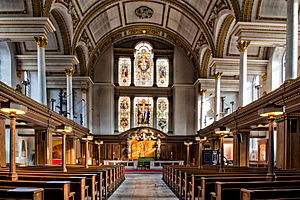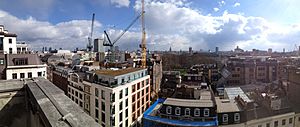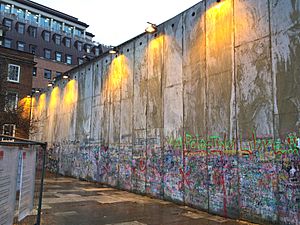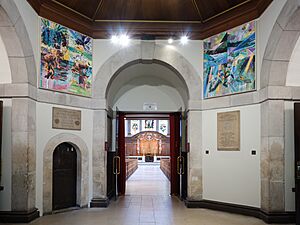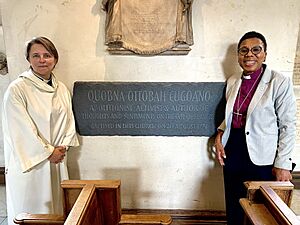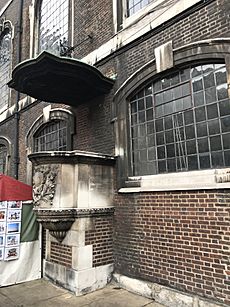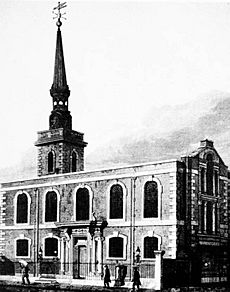St James's Church, Piccadilly facts for kids
Quick facts for kids St James's Church, Piccadilly |
|
|---|---|
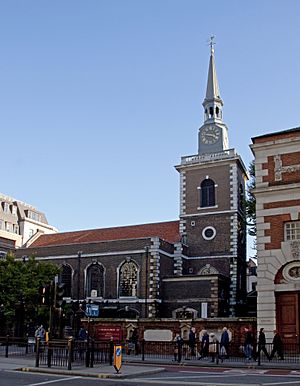
The church in 2011 51°30′31″N 0°8′12″W / 51.50861°N 0.13667°W
|
|
| Location | Piccadilly, London |
| Country | England |
| Denomination | Church of England |
| Churchmanship | Liberal |
| History | |
| Dedication | James the Great |
| Dedicated | 13 July 1684 |
| Architecture | |
| Heritage designation | Grade I |
| Architect(s) | Christopher Wren |
| Administration | |
| Diocese | Diocese of London |
St James's Church, Piccadilly is an Anglican church in the heart of London, England. It is also known as St James's Church, Westminster or St James-in-the-Fields. The famous architect Sir Christopher Wren designed and built this church.
The church is made of red brick with special Portland stone details. Inside, it has balconies on three sides, held up by square pillars. The main hall, called the nave, has a rounded ceiling that looks like a barrel. This ceiling is supported by fancy Corinthian columns. The beautiful carved marble font (where baptisms happen) and the wooden screen behind the altar (called a reredos) are amazing works by Grinling Gibbons. In 1902, a pulpit (a raised stand for speaking) was added to the outside north wall. It was designed by Temple Moore and carved by Laurence Arthur Turner. It was damaged in 1940 but was fixed when the rest of the church was repaired.
Contents
History
In 1662, Henry Jermyn, 1st Earl of St Albans, was given land to build homes on what was then the edge of London. He set aside space for a church and churchyard on the south side of what is now Piccadilly. Christopher Wren became the architect in 1672. The church was officially opened on July 13, 1684, by Henry Compton, the Bishop of London. In 1685, the area around the church became its own parish, called St James.
The church was badly damaged during the London Blitz on October 14, 1940, when bombs fell on London during World War II. After the war ended, Sir Albert Richardson led the restoration work. Special builders, Rattee and Kett, helped fix the church, and the repairs were finished in 1954. The old spire, which was covered in lead, was replaced with a much lighter copy made of fibreglass. The restored inside of the church, with its benches and lights, is a rare example of Richardson's complete church design. After the Second World War, Viscount Southwood created Southwood Garden in the churchyard. It was a garden of remembrance to honor the bravery of Londoners. Queen Mary opened it in 1946.
What the Church Does Today
Like many churches in central London, St James's saw fewer people attending in the 1960s and 1970s. In 1980, when Donald Reeves became the rector, he was told to simply keep the church open. During the 1980s and 1990s, the number of people and activities grew. The church became known for being a progressive, liberal, and active church. This continues today. The people who attend prefer to call themselves a "community" rather than a "congregation." Their activities often center around the Eucharist, which is a main Christian sacrament.
The community has many groups, including those for spiritual exploration, labyrinth walking, and Julian prayer meetings. There's also the Vagabonds group, which discusses ideas and meets in a local pub, named after a William Blake poem. An LGBT group and many others also meet here. The community has strongly supported the ordination of women (allowing women to become priests), fair treatment for asylum seekers, and helping those in poverty. They celebrate what they call the "radical welcome" found in the Christian Gospels. In 2023, the church held a drag show, which received some criticism for being "inappropriate." In May 2024, St James's was the first church to have a show garden at the RHS Chelsea Flower Show. This garden, called 'Imagine the World to be Different,' won a gold award. It was designed by Robert Myers to show how green spaces in cities can help people feel better. It also supported fundraising for the Wren Project, which aims to improve the church and its garden.
Organ
The west wall of the church features a grand organ case made of carved and gilded oak by Grinling Gibbons. This case originally held an organ built by Renatus Harris in 1691 for Whitehall Palace. It was moved to St James's in 1691. In 1852, J. C. Bishop completely rebuilt this organ. He also added the choir case that now sits in front of the original Gibbons case. A project to restore the organ has been ongoing since at least 1982. The current plan is to build a new organ inside the historic case. For now, the case is empty, and an electronic organ is used instead.
Concerts
Concerts are often held at the church. Many popular musicians have performed here, including John Grant, Tokio Myers, Victoria Canal, R.E.M., and folk musician Laura Marling. The Indian-American music group Penn Masala and Devin Townsend have also performed.
Creative Art Programme
From 2009 to 2010, Hauser & Wirth, a modern art gallery, held outdoor sculpture exhibitions in Southwood Garden. The first exhibition showed works by Swiss sculptor Hans Josephsohn.
From December 23, 2013, to January 5, 2014, an event called "Bethlehem Unwrapped" protested the Israeli West Bank barrier. It included an art display by Justin Butcher, Geof Thompson, and Dean Willars. This display featured a large replica of a section of the wall. The church said that the wall blocking the view of the church was part of the protest's message.
In October 2022, artist Jesse Darling, who was nominated for the Turner Prize, installed a new artwork called Miserere in the church. This happened after he spent some time working in the church's bell tower.
In September 2023, new murals by Che Lovelace were revealed in the church. These murals marked 250 years since the abolitionist Ottobah Cugoano was baptized at St James's in 1773. This was the first permanent artwork the church had ever asked for, and the first in the world to honor Cugoano.
Rectors of St James's
- 1685–1692 Thomas Tenison (later Archbishop of Canterbury)
- 1692–1695 Peter Birch
- 1693–1706 William Wake (later Archbishop of Canterbury)
- 1706–1709 Charles Trimnell (also Bishop of Norwich from 1708)
- 1709–1729 Samuel Clarke (a philosopher)
- 1729–1733 Robert Tyrwhitt
- 1733–1750 Thomas Secker (later Archbishop of Canterbury)
- 1750–1759 Charles Moss
- 1759–1763 Samuel Nicolls
- 1763–1802 William Parker
- 1802–1825 Gerrard Andrewes (also Dean of Canterbury from 1809)
- 1825–1845 John Giffard Ward
- 1846–1853 John Jackson (later Bishop of Lincoln then London)
- 1853–1895 John Edward Kempe
- 1895–1900 Alfred Barry (formerly Bishop of Sydney)
- 1900–1914 Joseph McCormick
- 1914–1918 William Temple (later Archbishop of Canterbury)
- 1918–1922 Herbert Priestley Cronshaw
- 1922–1954 Charles Lambert
- 1954–1967 John Brewis
- 1967–1980 Bill Baddeley
- 1980–1998 Donald Reeves
- 1999–2009 Charles Hedley
- 2010– Lucy Winkett
Other Staff
- Leopold Stokowski was the choirmaster from 1902 to 1905. He then moved to New York for a similar job.
Notable Baptisms
- Sir Joseph Banks, baptized February 13, 1743.
- William Blake, baptized 1757.
- Ottobah Cugoano, baptized (as John Stuart) on August 20, 1773.
- George Thomas Smart, baptized June 2, 1776.
- Philip Stanhope, 4th Earl of Chesterfield
- Lord Chatham
Notable Weddings
- John Ross and Alicia Arnold, who were the great-grandparents of Francis Scott Key (who wrote the American national anthem), were married here.
- The Scottish composer James Oswald married Mary Ann Melvill on February 12, 1744.
- Ince and Mayhew, who founded a furniture making company, married sisters in a double wedding here in 1762.
- Frederick de Horn and Angelica Kauffman married in 1767. Horn was an imposter who was already married, and Kauffman was a successful artist.
- George Bass, an explorer of Australia, married Elizabeth Waterhouse in 1800.
- Michael William Sharp, a portrait painter, married the actress and dancer Arabella Menage in 1804.
- Georges-Alexis, marquis d'Amboise, and Louisa Barwell married in 1815.
- Philip Hardwick, the architect, married Julia Shaw in 1819.
- General Sir Robert Arbuthnot married Harriet Smith in 1826.
- Prince Friedrich Wilhelm von Hanau married actress Auguste Birnbaum in 1856.
- In 1856, George Augustus Hopley married Felicité Claudine Rancine on July 26.
- On November 5, 1865, Samuel Baker, an explorer, married Florence Barbara Maria von Sass, whom he had rescued when she was a girl.
- In 1873, the actor and dancer Fred Vokes married actress Martha Isabella 'Bella' Moore.
- John Cyril Porte, an aviation pioneer, married Minnie Miller on August 16, 1916.
- Robert Graves, an author and poet, married Nancy Nicholson in the church in 1918.
- John Seward Johnson I, an American heir, married Ruth Dill in 1924.
- James Arbuthnot MP married Emma Broadbent in 1984.
- The marriage of Flora Ogilvy, granddaughter of Princess Alexandra, The Honourable Lady Ogilvy, and Timothy Vesterberg was blessed in the church on September 10, 2021.
Notable Burials
- John Arbuthnot, buried 1735.
- Charles Bridgeman, King's Gardener, buried July 22, 1738.
- Sir Charles Asgill, 2nd Baronet.
- Sir George Baker, 1st Baronet, physician to King George III.
- Mary Beale, one of the first professional women artists, buried 1699.
- Robert Anning Bell, artist and designer.
- Lieutenant-General Sir Colin Campbell, a British Army officer.
- Charles Cotton, poet and writer.
- Sir Richard Croft, 6th Baronet, physician to the British Royal Family.
- William Douglas, 4th Duke of Queensberry.
- William Elliot of Wells, buried 1764.
- James Gillray, a famous caricaturist.
- Lieutenant General Hugh Mackay Gordon, a British Army officer.
- The Earl of Grantham.
- Lord Anne Hamilton.
- Field Marshal Studholme Hodgson, a British Army officer.
- William Hunter, an anatomist.
- Pedro Vicente Maldonado, an Ecuadorian scientist.
- William McGillivray and his wife, Magdalen MacDonald.
- Stephen Peter Rigaud, a mathematical historian.
- David Ross, an actor.
- Bartholomew Ruspini, a surgeon-dentist and helper of others.
- Benjamin Stillingfleet, a botanist.
- Thomas Sydenham (1624–89).
- Henry Sydney, 1st Earl of Romney.
- Samuel Turner, an early British visitor to Tibet, buried 1802.
- Willem van de Velde, the elder, a marine painter.
- Willem van de Velde, the younger, a marine painter.
- Frances Deering Wentworth.
Notable Memorials
- William Blake, a famous poet and painter.
- Sir William Bowman, 1st Baronet, a surgeon known for microscope research.
- Richard Bright, a doctor who studied kidney disease.
- Mary Delany, an artist known for her "paper mosaicks."
- William Curtis Green, an architect.
- General John Studholme Hodgson, a British Army officer.
- Sir Herbert Hughes-Stanton, a painter of landscapes.
- Francis Ernest Jackson, a painter and designer.
- Sir George Johnson, a doctor known for cholera and kidney diseases.
- Joseph McCormick, a cricketer and chaplain to royalty.
- Frederick William Pomeroy, a sculptor.
- Sir Henry Rushbury, a painter.
- Sir James Jebusa Shannon, an Anglo-American artist.
- Air Vice Marshal Sir Arthur Vyell Vyvyan, an officer in the Royal Navy and Royal Air Force.
- George Spencer Watson, a portrait artist.
- William Yarrell, a zoologist and naturalist.
Detached Burial Ground
| Saint James, Westminster Improvement Act 1789 | |
|---|---|
| Act of Parliament | |
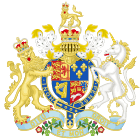
|
|
| Long title | An Act for providing an additional Burying Ground for the Parish of Saint James, Westminster, and erecting a Chapel adjoining thereto, and also a House for the Residence of a Clergyman to officiate in burying the Dead. |
| Citation | 29 Geo. 3. c. 47 |
| Dates | |
| Royal assent | 31 July 1789 |

St James's Church also had a separate burial ground in Camden. It was used from 1790 to 1853. This land was obtained through a special law passed in 1789. This law also allowed for a small chapel to be built for the parish, designed by Thomas Hardwick, which opened in 1791.
When Euston Station expanded for the railway around 1887, part of the burial ground was built over. To avoid public upset, the remains found there were moved to St Pancras Cemetery. The Gardens were closed to the public in 2017 for the High Speed 2 (HS2) rail project. Between October 2018 and 2020, archaeologists working on HS2 dug up about 40,000 burials. It was planned to re-bury these remains after experts called osteo-archaeologists studied them. It was decided in 2019 that the remains would be re-buried at Surrey's Brookwood Cemetery. However, Matthew Flinders' remains were buried in his home village of Donington, Lincolnshire. Work to prepare for the arrival of the remains at Brookwood began around August 2020 and was completed after November 2020. In spring 2023, the church hosted an exhibition about the St James's Burial Ground with the Museum of London Archaeology.
Notable people buried here included:
- James Christie (1730–1803), an auctioneer.
- Matthew Flinders (1774–1814), a naval officer and explorer, whose burial was moved in January 2019.
- Lord George Gordon (1751–1793), a politician.
- Bill Richmond (1763–1829), a boxer.
- John Charles Felix Rossi (1762–1839), an English sculptor.
- Thomas Garnett (1766–1802), a physician and natural philosopher.
See also


